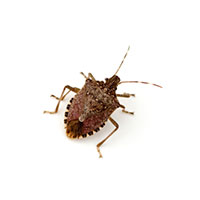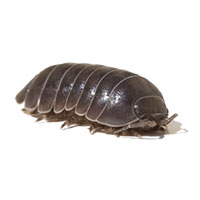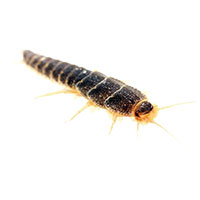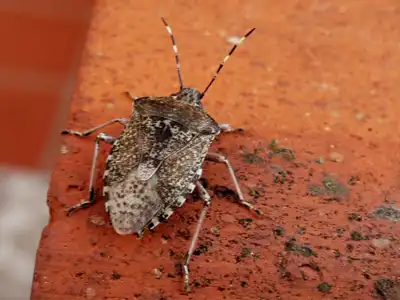
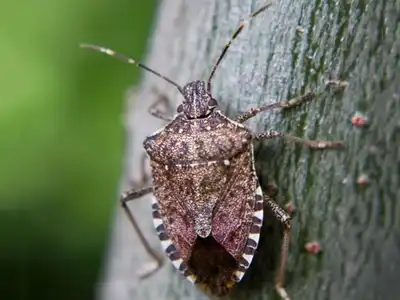
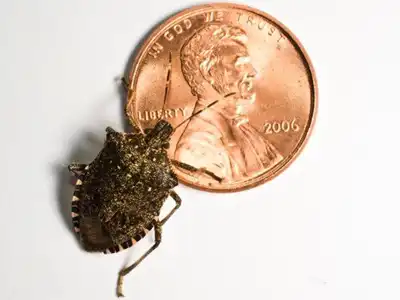
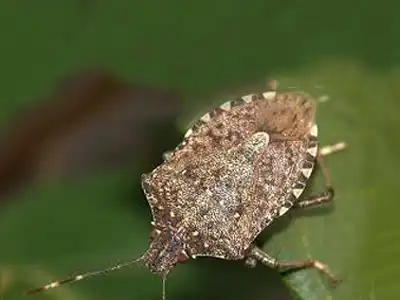
Brown Marmorated Stink Bugs in Wisconsin
Stink bugs, although largely harmless, come with a major drawback – the obnoxious odor they emit when they sense danger or are crushed.
Brown Marmorated Stink Bug Diet
Stink bugs are major agricultural pests that consume a number of different plants and crops including apples, pears, peaches, field corn, soybeans, tomatoes, lima beans, and green peppers. The stink bug will also feed on ornamental plants and larger trees, such as maple, birch, and dogwood.
Brown Marmorated Stink Bug Habitat
Mainly a nuisance pest to homeowners, the insect becomes an irritant by attempting to overwinter in man-made structures. Overwintering occurs in large numbers around building foundations and ground-floor windows. They gather on the south and west sides of buildings when the sun heats exposed surfaces. Even though they regularly seek shelter indoors during the colder months, stink bugs will not reproduce or feed inside human habitations, despite the common fears of homeowners.
Brown Marmorated Stink Bug Life Cycle
Eggs
Adults emerge from overwintering in April or May to mate and lay eggs. Shaped like barrels, the eggs appear white or pale green and are deposited on the underside of the leaves of a host plant. A single female can lay up to 400 eggs which hatch after three to seven days.
Nymphs
After hatching, stink bug nymphs go through five instars that cause the developing insects to molt and grow with each one. Each instar takes about a week to complete.
Adults
Adult stink bugs achieve sexual maturity around two weeks after the final molt. Brown marmorated stink bugs usually only produce a single generation each year, but warmer springs and summers may permit up to three generations of offspring.
Brown Marmorated Stink Bug Damage
While they do not bite, sting, or cause damage to your home, the smell brought by these invaders can be very difficult to eliminate. They have the ability to cause damage to a variety of crops and ornamental plants.
Signs of an Infestation
Sight and Smell
Actually seeing the insects or smelling the foul odor they produce when disturbed are the most prevalent signs of a stink bug infestation. Look for stink bugs around lights, crawling on walls or ceilings, or clinging to draperies or other window treatments.
Entry Points
Stink bugs are often found near potential entry points, such as chimneys, cracks in the wall or foundation, torn screens, window frames, and gaps around utility pipes or cables.
Warmth
Commonly attracted to the sunny exterior walls of homes and other structures and can be found in these locations.
Attraction
As common home invaders, stink bugs may seem to continuously appear. By releasing an aggregation pheromone that attracts other stink bugs to the area, the brown marmorated stink bug remains a persistent pest.
Brown Marmorated Stink Bug Prevention & Control
Stink Bug Prevention
To help prevent the insects from continuously invading, caulk, and seal cracks around windows, doors, siding, utility pipes, electrical outlets, and chimneys. Sealing all points of entry that stink bugs can access, as well as replacing any damaged screens on doors and windows, is the best way to keep the pests out.
Once stink bugs make their way indoors, there is little that can be done beyond vacuuming them up, thus preventive measures are strongly recommended.
Stink Bug Control
Professional Control
Your Batzner Service Specialist will come to your property to determine the proper treatment method. Fall is the time to help prevent stink bugs from using your building or home as a refuge for the coming winter season. With the onset of cooler temperatures in autumn, these insects congregate on buildings in search of overwintering sites. To prevent pest entry, treatment must be applied before the insects begin to enter buildings during late September or early October to be effective. Once the pests have entered the building, treatments can be done in winter or spring. The most effective pest management option is prevention. Prevention is the key!
DIY Brown Marmorated Stink Bug Control
Your first priority should be to look for entry points into your home. Possible entrances include underneath the siding, around door and window frames, utility pipes, and chimneys. Reduce stink bug invasions by doing the following:
- Seal holes in exterior walls larger than the diameter of a pencil
- Seal gaps and cracks around door and window frames
- Install door sweeps
- Ensure doors and windows are tight-fitting
- Screen exterior attic openings and vents
- Seal entry points with caulk or good quality silicone sealant (including around chimneys)
If you do find stink bugs in your home, you can:
- Remove both live and dead stink bugs with a vacuum cleaner – the vacuum may smell like stink bugs for a period of time. Always remember to empty your vacuum immediately after using on stink bugs.
- Sweep the stink bugs up using a broom and dustpan and discard them in an outdoor trash receptacle.
For large-scale stink bug infestations, count on a professional pest management service to take care of the problem knowledgeably and successfully.
Stink Bug FAQ
Can stink bugs fly?
They are strong fliers and can fly (more than one mile a day) to a new habitat or may even hitch a ride in shipping containers or on cars.
Can stink bugs bite or sting?
The brown marmorated stink bug is not capable of biting or stinging humans.
Why do stink bugs stink?
Stink bugs rely on their foul smell for protection against predators such as birds, lizards, and mice, or any other animals that prey on them. The noxious chemical flows from the two glands on the stink bug’s thorax.
What attracts stink bugs?
Like many other household pests, stink bugs are attracted to the warmth that can be found inside homes or businesses. Stink bugs are attracted to bright lights so it is advised to keep exterior lighting turned off and window blinds pulled down.
Need help with Stink bugs?
We'll call you! Leave your information below.

